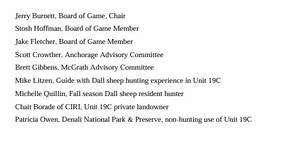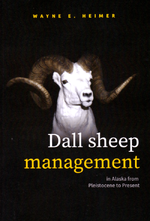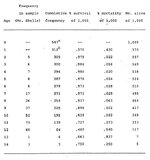Some here may be following the unit 19Csheep issues in AK.
Short story is that sheep in 19c, the central/wester Alaska Range, are hurting bad, just like they are in most of the other parts of the state.
Two years ago the state shut down all non-resident hunting in 19c and put together a “working group” to make recommendations to the board of game on what to do with 19c into the future.
The working group met last week and a friend that was at the meeting shared their final recommendations with me today.
You can see those here and attached: https://www.adfg.alaska.gov/static/...2025/sheep_10-17-24/recommendation-litzen.pdf
I’ve been tracking this pretty closely as I’ve spent a fair bit of time in 19c over the years and the place is near and dear to my heart. I’ve seen firsthand the dramatic and rapid decline of the population and what used to be problems with over crowding and way too much commercial pressure. Not long ago, when populations were better, guides took 60-70% of the sheep out of this area.
I guess I shouldn’t be surprised at most of the recommendations, that are obviously aimed at curtailing resident opportunities while preserving guaranteed commercial access, given the make up of the working group. But this was far worse than I was thinking they would do.
A few points and thoughts in response.
1. In putting in place restrictions on harvest and in making comments like “hopefully with …lighter harvest sheep populations will be back on track” the group seemingly ignores the science of full curl management which says that harvest doesn’t affect sheep populations. As such, a complete closure and/or limiting resident opportunity accomplishes nothing, in terms of the population, and is a needless waste of opportunity.
2. One ram every 4 years for residents is, again, a needless loss of opportunity if, again, harvest doesn’t negatively impact population recovery. It would however, confidently, limit competition with the guided clients. Limiting non res to 1 every 6 is meaningless since 90+ percent of non res hunters are one and done.
3. The sole use areas for guides is likely a good thing and a long time coming. This will be an interesting case study if the state can organize that. The problem of where the other displaced guides go to still needs addressed as most other areas in the state are already at capacity for guides and resident pressure.
I see a lot of problems and faulty logic with what has been proposed for 19c, but also problematic is what has not been proposed there or statewide. 19c is not unique with the problems it is facing. 16b that shares a boundary with 19c is hurting just as bad. I don’t understand why this working group can’t focus on statewide issues than than one area.
Likewise there are some things that do affect sheep at the population level that could be addressed that have largely been ignored, sub-legal harvest and the age of “legal” rams trending down for example.
Overall super disappointed at the outcome of the working group and there recommendations.
Hopefully there is another opportunity to comment before the board of game moves forward on any of this.
Lots of other thoughts on all of this. Hoping to get a few takes from others interested in this business.
Short story is that sheep in 19c, the central/wester Alaska Range, are hurting bad, just like they are in most of the other parts of the state.
Two years ago the state shut down all non-resident hunting in 19c and put together a “working group” to make recommendations to the board of game on what to do with 19c into the future.
The working group met last week and a friend that was at the meeting shared their final recommendations with me today.
You can see those here and attached: https://www.adfg.alaska.gov/static/...2025/sheep_10-17-24/recommendation-litzen.pdf
I’ve been tracking this pretty closely as I’ve spent a fair bit of time in 19c over the years and the place is near and dear to my heart. I’ve seen firsthand the dramatic and rapid decline of the population and what used to be problems with over crowding and way too much commercial pressure. Not long ago, when populations were better, guides took 60-70% of the sheep out of this area.
I guess I shouldn’t be surprised at most of the recommendations, that are obviously aimed at curtailing resident opportunities while preserving guaranteed commercial access, given the make up of the working group. But this was far worse than I was thinking they would do.
A few points and thoughts in response.
1. In putting in place restrictions on harvest and in making comments like “hopefully with …lighter harvest sheep populations will be back on track” the group seemingly ignores the science of full curl management which says that harvest doesn’t affect sheep populations. As such, a complete closure and/or limiting resident opportunity accomplishes nothing, in terms of the population, and is a needless waste of opportunity.
2. One ram every 4 years for residents is, again, a needless loss of opportunity if, again, harvest doesn’t negatively impact population recovery. It would however, confidently, limit competition with the guided clients. Limiting non res to 1 every 6 is meaningless since 90+ percent of non res hunters are one and done.
3. The sole use areas for guides is likely a good thing and a long time coming. This will be an interesting case study if the state can organize that. The problem of where the other displaced guides go to still needs addressed as most other areas in the state are already at capacity for guides and resident pressure.
I see a lot of problems and faulty logic with what has been proposed for 19c, but also problematic is what has not been proposed there or statewide. 19c is not unique with the problems it is facing. 16b that shares a boundary with 19c is hurting just as bad. I don’t understand why this working group can’t focus on statewide issues than than one area.
Likewise there are some things that do affect sheep at the population level that could be addressed that have largely been ignored, sub-legal harvest and the age of “legal” rams trending down for example.
Overall super disappointed at the outcome of the working group and there recommendations.
Hopefully there is another opportunity to comment before the board of game moves forward on any of this.
Lots of other thoughts on all of this. Hoping to get a few takes from others interested in this business.






